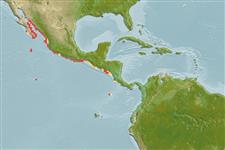Teleostei (teleosts) >
Blenniiformes (Blennies) >
Chaenopsidae (Pike-, tube- and flagblennies)
Etymology: Acanthemblemaria: Greek, akantha = thorn + Greek, emblema, -atos, anything that is nailed, knocked in; also anything with bass or high relief (Ref. 45335).
Environment: milieu / climate zone / depth range / distribution range
Ecology
Marine; reef-associated; depth range 2 - 15 m (Ref. 11482). Tropical; 29°N - 4°N, 112°W - 85°W (Ref. 56271)
Eastern Central Pacific: southern Baja California to Acapulco in Mexico and the Revillagigedo Islands.
Size / Weight / Age
Maturity: Lm ? range ? - ? cm
Max length : 6.0 cm TL male/unsexed; (Ref. 11482)
This species is distinguished from A. hastingsi in having melanophores on the lower jaws that do not reach all the way to the distal end; it possess a red primary bright head color (vs. orange), and the windowing effect around that color is not present or is less distinct; almost not having melanophores reaching the base of the first dorsal fin and more typically have a dark, round spot or stretched out spot instead of a swath (Ref. 84469).
Inhabits empty barnacles and worm or mollusk tubes on rocky reefs. Feeds on zooplankton.
Life cycle and mating behavior
Maturities | Reproduction | Spawnings | Egg(s) | Fecundities | Larvae
Allen, G.R. and D.R. Robertson, 1994. Fishes of the tropical eastern Pacific. University of Hawaii Press, Honolulu. 332 p. (Ref. 11482)
IUCN Red List Status (Ref. 130435)
Threat to humans
Harmless
Human uses
Tools
Special reports
Download XML
Internet sources
Estimates based on models
Preferred temperature (Ref.
123201): 23.3 - 29.1, mean 28 °C (based on 129 cells).
Phylogenetic diversity index (Ref.
82804): PD
50 = 0.5000 [Uniqueness, from 0.5 = low to 2.0 = high].
Bayesian length-weight: a=0.00457 (0.00183 - 0.01143), b=3.08 (2.86 - 3.30), in cm total length, based on LWR estimates for this (Sub)family-body shape (Ref.
93245).
Trophic level (Ref.
69278): 3.4 ±0.45 se; based on food items.
Fishing Vulnerability (Ref.
59153): Low vulnerability (10 of 100).
Nutrients (Ref.
124155): Calcium = 175 [87, 335] mg/100g; Iron = 0.905 [0.511, 1.595] mg/100g; Protein = 18 [17, 19] %; Omega3 = 0.101 [0.051, 0.195] g/100g; Selenium = 18.1 [7.9, 42.8] μg/100g; VitaminA = 345 [107, 1,147] μg/100g; Zinc = 2.19 [1.39, 3.27] mg/100g (wet weight);
